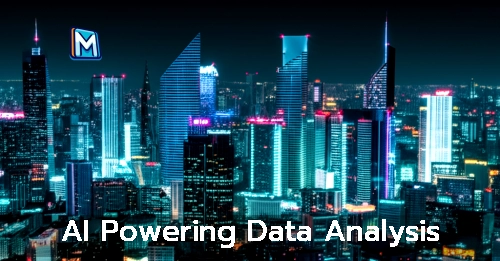The AI-Powered Data Analysis Process: Beyond Human Limits
Traditional data analysis often involves manual processes, statistical sampling, and human interpretation, which quickly become overwhelmed by the sheer volume, velocity, and variety of Big Data. AI overcomes these limitations through sophisticated algorithms and computational power. Here's how:
Data Ingestion and Preprocessing at Scale:
The first step involves ingesting data from myriad sources – structured databases, unstructured text documents, images, audio, video, sensor data from IoT devices, social media feeds, and more. AI-powered tools excel at this, capable of ingesting data streams in real-time. Critically, AI also automates the laborious process of data cleaning, transformation, and validation, ensuring the data is accurate, consistent, and ready for analysis. Generative AI, for example, is increasingly used to automate data cleaning and structuring, freeing up resources for strategic initiatives.
บทความที่เกี่ยวข้องและแนะนำ:
Pattern Recognition and Machine Learning (ML):
At the heart of AI's data analysis capability lies Machine Learning. ML algorithms are trained on vast datasets to identify complex patterns, correlations, and anomalies that are invisible to the human eye.
Supervised Learning: Models are trained on labeled data to learn relationships between inputs and outputs. For instance, in fraud detection, AI learns from historical transactional data labeled as "fraudulent" or "legitimate" to identify suspicious new transactions.
Unsupervised Learning: Algorithms discover hidden patterns and structures in unlabeled data. This is crucial for segmentation (e.g., customer segmentation) or anomaly detection (e.g., identifying unusual network activity in cybersecurity).
Deep Learning: A subset of ML, deep learning uses multi-layered neural networks inspired by the human brain. These networks are exceptionally powerful at processing highly complex and unstructured data like images, audio, and natural language. For example, in healthcare, deep learning analyzes medical images to detect early signs of diseases with remarkable accuracy.
Natural Language Processing (NLP) for Unstructured Text:
A significant portion of Big Data is unstructured text, found in customer reviews, social media posts, emails, and reports. NLP, a branch of AI, enables machines to understand, interpret, and generate human language.
Sentiment Analysis: NLP can gauge public sentiment towards a product or brand by analyzing text data, providing insights into customer perception.
Entity Recognition: It identifies and extracts key information, like names, organizations, or locations, from unstructured text.
Text Summarization: NLP can distill large documents into concise summaries, saving significant time for analysts.
Computer Vision for Image and Video Data:
For visual data, AI leverages Computer Vision. This technology allows AI systems to "see" and interpret images and videos, recognizing objects, faces, activities, and anomalies. Applications range from quality control in manufacturing (identifying defects on a production line) to security surveillance and medical imaging analysis.
Predictive and Prescriptive Analytics:
Beyond merely understanding past data, AI excels at forecasting future outcomes (predictive analytics) and recommending optimal actions (prescriptive analytics). By leveraging historical data and identifying trends, AI models can predict customer churn, equipment failures, market shifts, or disease outbreaks. Based on these predictions, AI can then suggest the best course of action to achieve desired business outcomes, whether it's optimizing inventory, personalizing marketing campaigns, or even recommending drug dosages.
Real-time Processing and Edge AI:
The demand for instantaneous insights has led to advancements in real-time AI analytics. AI systems can now process streaming data as it is generated, enabling immediate responses to events. Furthermore, Edge Computing is bringing AI capabilities closer to the data source (e.g., on IoT devices), reducing latency and bandwidth usage, which is crucial for applications like autonomous vehicles and smart cities.
Recent Advancements and Future Outlook:
The landscape of AI data analysis is constantly evolving:
Generative AI with Big Data: The fusion of Generative AI (like LLMs) with Big Data analytics is a major trend. This allows for more sophisticated data preparation, natural language interaction with data, and the creation of synthetic datasets for training, accelerating workflow and improving accuracy.
AI-Powered Data Visualization: AI is transforming how insights are presented. It automates the identification of significant patterns, ranks insights by relevance, and generates natural language summaries or user-friendly visualizations, making complex data digestible for decision-makers.
Data-Centric AI: There's a growing emphasis on "Data-Centric AI," which focuses on improving the quality and organization of data used to train AI models. The idea is that better data leads to better AI performance, even with simpler models.
Democratization of AI Analytics: No-code/low-code AI tools and platforms are making advanced data analysis accessible to business users without deep technical knowledge, empowering more individuals to leverage predictive capabilities.
Multimodal AI: This emerging area involves AI models that can process and integrate information from multiple sources simultaneously, such as text, images, and audio, leading to more comprehensive insights, especially beneficial for complex data in fields like fintech.
In conclusion, AI's ability to analyze vast amounts of data is not merely about processing speed; it's about uncovering hidden value, driving smarter decisions, and creating unprecedented opportunities for businesses worldwide. As AI technologies continue to advance, their capacity to interpret and leverage data will only grow, solidifying AI's role as the indispensable engine of modern enterprise.
magazineasp













